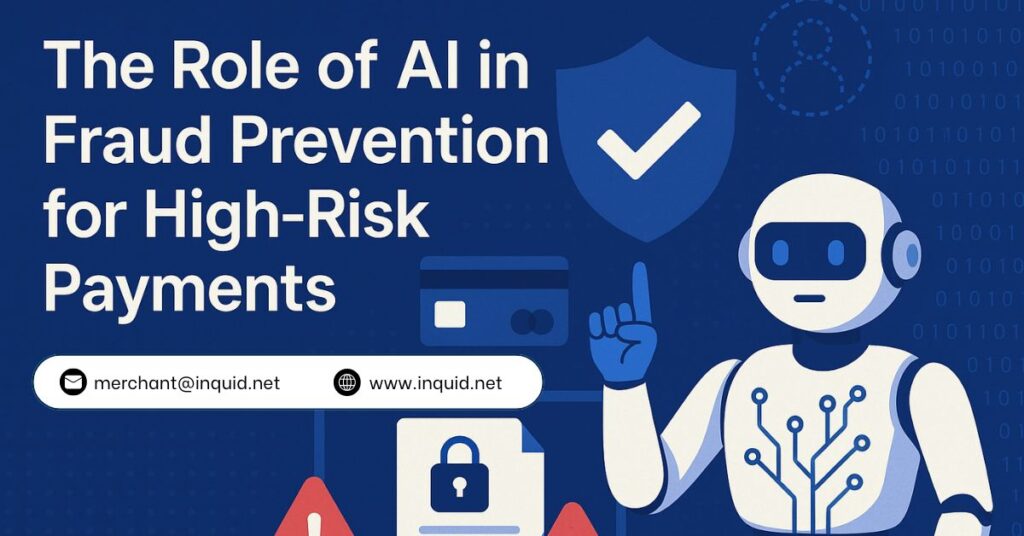
AI in fraud prevention for high-risk payments is becoming essential as fraud remains a daily concern for merchants in high-risk industries. When approval rates are already fragile and chargeback threats are frequent, losing a transaction to fraud isn’t just an operational issue—it can be a business risk.
AI isn’t a buzzword in this context. It’s becoming a critical defense system that helps high-risk merchants maintain approval stability, reduce fraud exposure, and improve overall payment reliability.
What AI Actually Does in High-Risk Fraud Detection
At its core, AI in fraud prevention is about pattern recognition. Unlike traditional rule-based systems that flag transactions only when set thresholds are hit, AI models learn from behavior. They detect patterns in transaction timing, location, card metadata, and behavioral inconsistencies that humans—or simple filters—would miss.
For example, an AI system can differentiate between a loyal customer placing an order from a new device and a stolen card being used across multiple countries within minutes. The difference? Accuracy, context, and the ability to keep the payment flow intact without blocking genuine users.
Why AI is Becoming a Must for High-Risk Merchants
If you’re in an industry flagged as high-risk—like adult, gaming, forex, or nutraceuticals—fraud prevention needs to go beyond the basics. Here’s why AI matters:
- It reduces false declines. High-risk merchants already face scrutiny from processors. Blocking too many genuine transactions due to outdated filters can kill customer trust.
- It protects your approval rate. AI minimizes fraud attempts without harming legitimate traffic, helping merchants stay in good standing with acquiring banks.
- It flags chargeback triggers early. Tools using AI can detect when a buyer is likely to dispute a transaction based on past behavior, allowing preemptive action.
You can learn more about how to manage chargebacks in high-risk payments here.
Fraud Tools Powered by AI: What to Look For
Not all fraud systems using AI are equal. Some are merely rebranded manual filters. Others are full-scale machine learning engines. The best ones include:
- Real-time risk scoring with dynamic updates
- Behavioral biometrics tracking (like typing speed, navigation flow)
- Smart velocity checks that adjust by customer profile
- Built-in compliance checks for region-specific payment rules
These aren’t gimmicks. They directly affect whether a merchant account stays active or gets flagged. In highly regulated environments, compliance risk is closely tied to fraud activity. AI makes staying compliant more proactive than reactive.
Faster Approvals Thanks to Better Risk Modeling
Acquiring banks care about risk exposure. If your fraud prevention stack looks weak, approval is either delayed or denied. With AI in fraud prevention for high-risk payments, you’re not just defending your business—you’re showing acquirers that you’re managing risk intelligently.
Merchants often underestimate how much fraud profiles affect approval times. But having a strong fraud model in place can make the process faster. Learn more about how inquid supports faster approvals for high-risk merchants.
Common AI-Driven Triggers to Watch Out For
AI tools often flag the following patterns as high risk:
- Multiple failed transactions from the same IP within a short window
- First-time buyers with high-ticket items
- Mismatched cardholder name and shipping address
- Inconsistent browser data across regions
These insights help merchants adjust risk settings without rejecting every edge-case transaction. That’s the real strength of AI—it adapts without breaking the system.
Integrating AI Without Overcomplicating Your Setup
Adding AI to your fraud stack doesn’t have to mean overhauling your entire gateway. Many fraud engines integrate via API or plug-in form with existing systems. But it’s important to assess your provider. Does your gateway offer AI-driven tools or are you relying on static filters?
If you’re unsure where to begin, start with these tips for high-risk payment processing. They’ll help frame the right questions before committing to a tool or provider.
Final Thoughts
AI isn’t magic. It’s not going to erase fraud or fix every approval issue overnight. But for merchants operating in industries where every transaction carries weight, it can be the difference between growth and being flagged. With the right fraud stack, backed by learning models that improve over time, high-risk merchants can move forward with more confidence.
If you’re building your payment infrastructure or rethinking fraud prevention strategies, make sure you’re not relying solely on outdated tools. Smart risk management is no longer optional—it’s a key business decision.
Frequently Asked Questions (FAQs)
How does AI help reduce fraud in high-risk payment processing?
AI helps by analyzing transaction patterns in real-time, identifying suspicious behavior like unusual location changes, repeated declines, or mismatched data. It can block or flag risky payments before they’re processed.
Is AI better than manual fraud detection for high-risk merchants?
Yes, AI is typically faster and more accurate. It detects complex fraud patterns that manual systems often miss and adapts based on new threats without needing manual updates.
Can AI improve my chances of merchant account approval?
Yes. A solid AI-based fraud system shows acquiring banks that you’re actively managing risk, which can improve your approval chances.
What industries benefit the most from AI in fraud prevention?
Industries like online gaming, adult, forex, CBD, and nutraceuticals—where chargeback rates are higher—benefit significantly from AI-based fraud prevention tools.
Do I need a separate AI tool, or do some gateways include it?
Some payment gateways include AI-powered fraud detection. Others require third-party tools. It’s important to check if your gateway supports real-time AI-based risk scoring.
